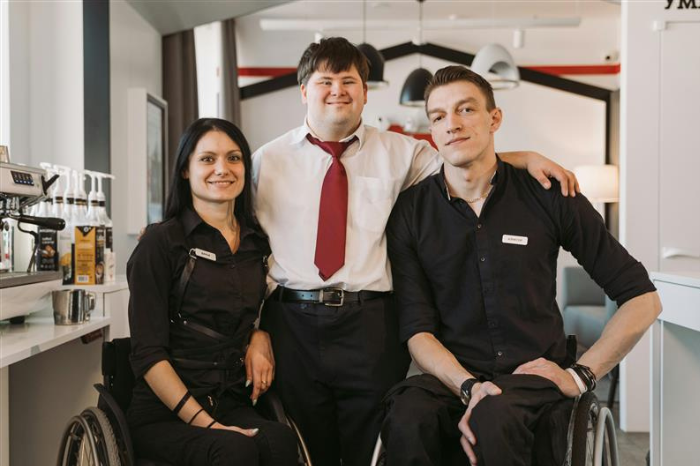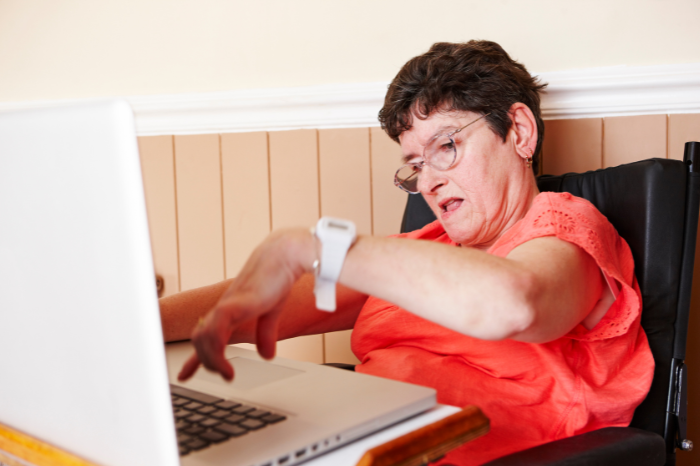
If you’re anything like most of us, chances are you regularly turn to the National Disability Insurance Scheme (NDIS) website as a source of truth for all things funding (and beyond!). But what happens when the theory on the page doesn’t match the practice in your life – where do you turn to then?
Take goal setting for example. The NDIS website says: ‘Your goals are not directly linked to your NDIS funding’ – but those with lived experience tell us that getting your goals right can play a big part in securing more money for supports, while getting them wrong can leave you grasping for funding and seeking a plan review pretty quickly.
We chatted to *Kate, a sibling of an NDIS participant, and Elizabeth Hickey, an independent support coordinator and mentor for people in the disability sector, about identifying and articulating well crafted goals that tie directly to the funding you need to deliver the outcomes you’re after.
Kate told us that at the start of her brother’s NDIS journey, he and his family didn’t really know what goals were for or how to set them. This meant he wasn’t telling the National Disability Insurance Agency (NDIA) what he wanted out of life, or the things he really needed, and therefore he wasn’t funded for the supports that could build his capacity and help him to thrive. But, once he and his family understood how to set NDIS goals – and how to ask for the supports you need – they put it into practice, and it changed everything.
Here’s the conversation we had with Kate.
In my brother’s early NDIS plans his ‘goals’ were very loosely worded. Really, they were a collection of thoughts and hopes he had for the future, but without any real roadmap of how he planned to get there, the people, tools and services he would need to support him along the way, and the funding he would require to turn those thoughts and hopes into reality.
In his current plan he’s been very clear about what he wants to achieve. For example, he wants to feel happy and well, he wants to be able to better regulate his emotions when he feels distressed, and he would like people to better understand and respond to his needs.
He’s tied the goal I mentioned earlier to a detailed, nitty gritty plan for achieving it – which includes having an up-to-date and effective positive behaviour support plan with identified strategies and supports to guide him, our family, and his formal supports.
He’s been very specific about having access to staff who are trained to support him correctly and who he knows well and trusts with his physical and emotional safety.
Because he lives in supported accommodation, he’s also stated that the staff that support him need to be focused on supporting him alone, and not working with a large group of participants at the same time, because that affects his safety and emotional wellbeing.
To achieve this specific goal, my brother’s been up front about the supports and funding he needs. He worked with an occupational therapist who prepared a functional capacity assessment for the NDIA. Then, he asked for funding to access allied health professionals who can work together to develop a positive behaviour support plan and implement it with his formal and informal supports, and a support coordinator to assist him to increase his independence, and to find and engage all the providers he needs.
He also asked for funding so his providers can offer appropriate training to their staff to ensure they are qualified to work with him and meet his needs.
At the start of his NDIS journey, my brother didn’t really know what goals were for in the NDIS, why they were so important, and what the risks were for him if he didn’t have them. No one really helped us to understand that and, as his family, we felt we were flying blind and unable to support him in the way we wanted to.
Then, we stumbled across a great disability advocate, and she changed everything. She worked with him – and with us – to make sure he was front and centre in every discussion about his NDIS plan, and his life.
She took a look at his goals, such as they were, and explained that they didn’t really speak about his desire to grow his independence and build his capacity, and they also didn’t show how he planned to make progress and what he needed to have in place to enable him to do that.
She told us he would have a much better chance of getting the funding he needed if he could demonstrate to the NDIA how his capacity would be built by progressing towards his goals – and how the Agency could measure it. And, of course, if we were able to submit a functional capacity assessment and other reports from a wide range of professionals to support my brother’s case for increased funding.
When we knew that, we went from a place where the goals in my brother’s plan were poorly structured and ineffective, to a place where they’re now the polar opposite. We all worked together with my brother to identify SMART goals – Specific, Measurable, Achievable, Relevant and Time-based – and everything changed.
The relief for him, and for us, when he finally got an NDIS plan with the funding he needed – in the budget categories he needed it in – was enormous. Finally, he was able to get on with living his life in the way he wants to live it, and we were at ease knowing he had the supports around him to make sure he could do that in a safe and happy way.
Elizabeth Hickey from AFA Support Coordination confirms that NDIS goals do impact plan funding.
“(Goals) provide the framework against which an NDIS plan is structured and how success is measured at review,” said Elizabeth. “Like each NDIS participant is unique, their NDIS plan should be individualised and clearly identify what they will work towards during their NDIS plan and how that will be achieved. A lot of this is articulated in goals.”
Elizabeth said a statement on the NDIS website that says: ‘Your goals are not directly linked to your NDIS funding’ is true and reflects the fact that NDIS goals don’t inform planners what funding is needed. However, she said the statement must not be taken to assume that goals have no positive or negative impact on a person’s NDIS plan.
“The more detailed and substantial – and, in some cases, granular – a goal is, the more scope there is to have important elements approved, which may be rejected when the goal is more general,” said Elizabeth.
She said key points to consider included that:
We asked Elizabeth to unpack what a well structured goal looks like and the outcomes it can achieve. Here’s what she said.
Let’s explore this by considering our young friend Jimmy.
Jimmy is 10 years old and has been trying for many years to learn to ride a bike because he ‘just wants to ride to school like everyone else’. He attends the local mainstream school and is focused on making friends and being more active. He has a disability that affects his social, gross and fine motor skills, and his ability to participate in the wider community.
Jimmy and his informal supports have worked with an occupational therapist and physiotherapist who have provided detailed feedback in their reports. They’ve also made recommendations and provided quotes and cost estimates around the funding Jimmy needs to achieve the goal of riding to school like everyone else.
In preparation for the planning meeting, Jimmy’s informal supports are trying to determine the most effective way to write the goal. Here are two options to approach this:
Goal 1 is not to be automatically discounted – it is clear, specific and measurable. However, while this is a great goal to have, it may actually result in less funding being approved.
To achieve this goal (depending on the evidence provided in reports and requests made), the NDIS may fund participation in a learn to ride program and some sessions with an occupational therapist to build the skills to get to and from school.
Goal 2 allows for much more consideration of the various components of the goal – requiring a more nuanced and customised set of supports (with their appropriate funding allocations). It details the specific things assessed independently as necessary to help Jimmy ride a bike to school like his friends. To achieve this, he needs to work on his coordination and participate successfully in a range of physical activities. It also identifies that Jimmy will need to work on his independence and personal safety skills, along with other social skills, so he can do the activities in a community or other setting with a range of people.
Another positive of having a broader goal like Goal 2 is that it will also allow Jimmy to do other things that require many of the same skills – this could include playing team sports, like basketball, or other physical activities. It may also include social development supports that assist with general independence tasks, like packing the dishwasher or mowing the lawn.
To assist in achieving Goal 2 (depending on the evidence provided in reports and requests made), the NDIS may fund a learn to ride program, social and community participation in a social skills program, an occupational therapist to assist with independence and safety skills, and physiotherapy sessions to assist with gross motor skills.
When preparing an NDIS goal, it can seem quite overwhelming. Breaking each goal down into its specific areas – just like we did with Jimmy – actually assists with this preparation by focusing the justification to a single outcome.
In general, here are a few things to remember when setting a goal.
1. The goal should ideally last the length of the plan
When a goal allows room to grow, it will be more flexible and increase opportunities for different methods of implementation.
In Goal 1, once Jimmy is able to ride to and from school, that goal has been achieved.
In Goal 2, not only could Jimmy learn to ride a bike, then learn to get to and from school, but he also can learn the road rules and skills needed to then do that independently, and hopefully go to different locations. But he could also use this goal to participate in therapy to increase independence and safety skills, an after school or school holiday skill building program based around physical activities, or even therapy targeted at active travel skills.
2. A goal should be flexible enough that it can adapt to changing situations
If, for any reason, Jimmy is no longer able to ride to school, Goal 1 is no longer achievable or valid.
Goal 2 allows Jimmy to increase his skills across a range of activities in any location – this allows for changes to situations to occur and the ability for different methods to achieve increases in skills to occur. This goal also allows for Jimmy to have choice and control over the activities he participates in at any given time (he may fall out of love with cycling over winter for instance).
3. The best goals are ones where more than one functional domain is being worked on
There are six NDIS functional domains: mobility, communication, social interaction, self management, learning, and self care.
In Goal 1, the focus is on mobility only. In Goal 2, by aiming to increase coordination, social participation, safety and independence, the goal meets mobility, communication, social interaction, learning, and self care.
4. Goals should reflect the reports and supporting evidence you provide
Make sure you discuss with supports what it is you want to achieve in your next plan before they write your reports, to better align client expectations with support opinions.
For Goal 1, therapy providers could easily support participation in a learn to ride program and leave it at that for a report.
For Goal 2, by discussing options for support and identifying that coordination, safety and independence skills, along with an increase in Jimmy’s social skills, will be needed for him to be able to achieve riding to school like everyone else, Jimmy’s NDIS supports can outline the wide range of supports needed so that a more complete package of funding is provided to help Jimmy achieve this goal.
5. Not all goals may be funded – however the supports needed to offset the impact of a disability on achieving that goal may be
For Goal 1, funding support for a child to participate in a learn to ride program is likely to be appropriate – especially for a 10-year-old like Jimmy. Funding for someone to escort Jimmy to and from school is less likely, as that is typically a parental responsibility.
For Goal 2, funding for support to participate in a learn to ride program – therapy that will assist in increasing safety, independence, and communication – may be appropriate, as may participation in group programs based in the community that are about increasing social skills and community participation.
While your NDIS goal may not directly impact your NDIS budget, if that goal is well written, considers all the supports needed, and is backed by evidence provided by supports in their reports and quotes, then you’re more likely to increase the scope of support provided in your next NDIS plan.
*Kate is a pseudonym to protect her brother’s privacy.


